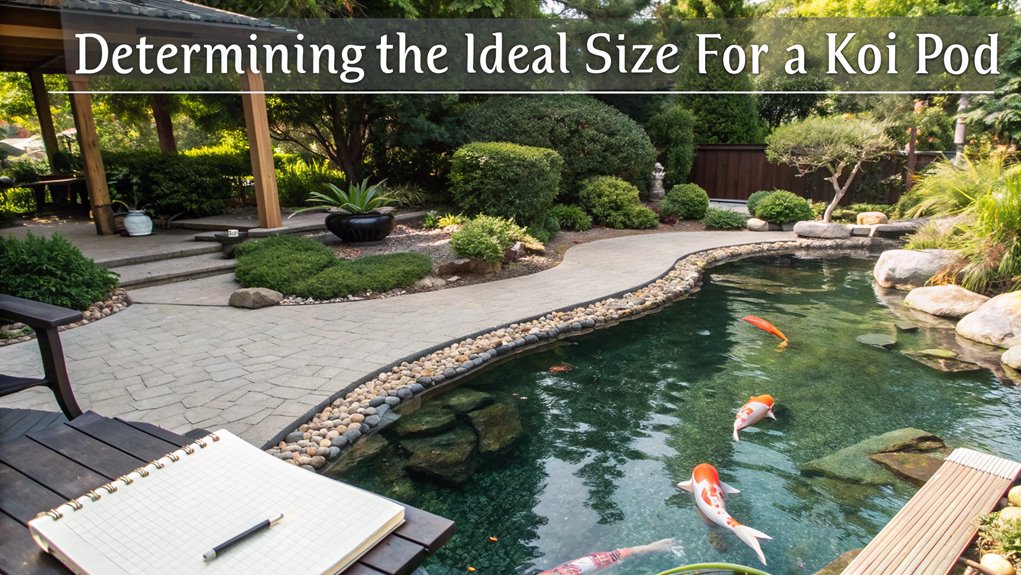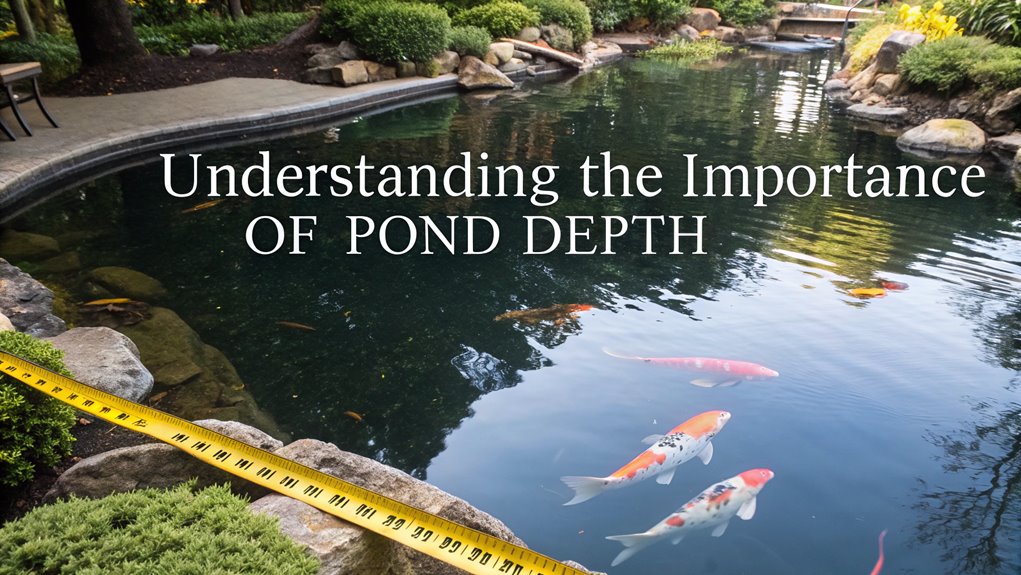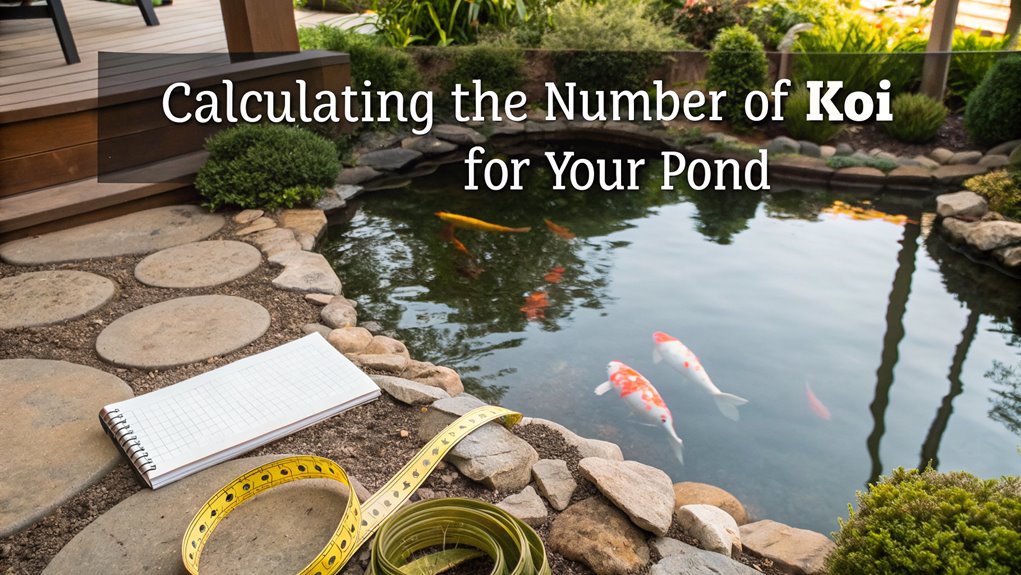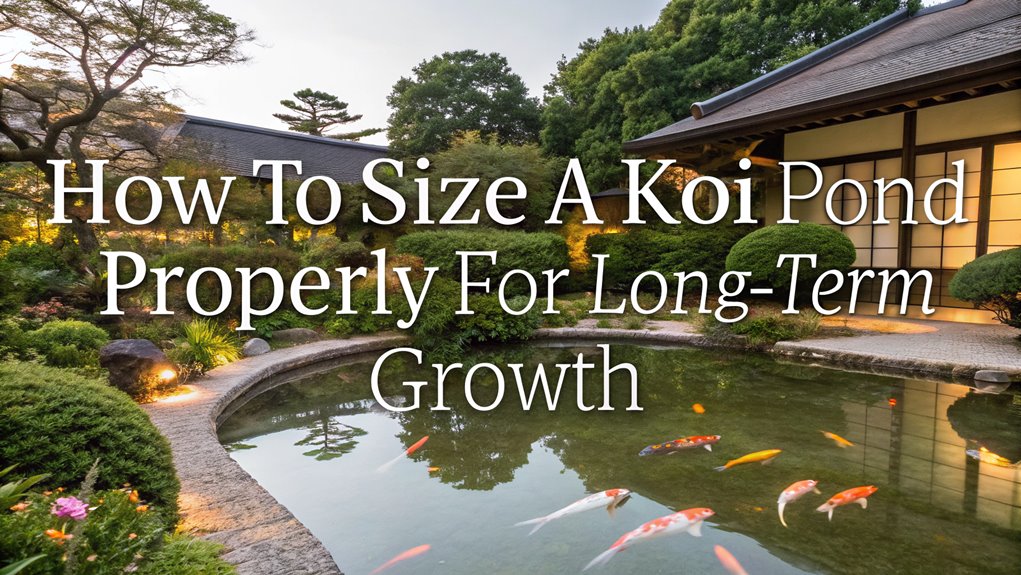To size a koi pond properly for long-term growth, ensure it holds at least 1,000 gallons, with 5,000 gallons ideal for multiple koi. Maintain a minimum depth of 3 feet to stabilize water temperatures and deter predators. Plan for around 250 gallons per small koi and 500 gallons per large koi. A robust filtration system is crucial. Calculate these factors meticulously to prevent overcrowding and maintain quality, and you’ll find further insights into optimization ahead.
Key Facts Summarized
- Ensure a minimum pond size of 1,000 gallons for basic koi health and growth.
- Allocate at least 5,000 gallons for larger koi to accommodate future growth.
- Maintain a minimum pond depth of 3-6 feet for temperature stability and predator protection.
- Follow stocking rules: 1 koi per 250 gallons for small, 1 per 500 gallons for large.
- Implement a robust filtration system tailored to the pond size for optimal water quality.
Determining the Ideal Size for a Koi Pond

When determining the ideal size for a koi pond, it’s crucial to consider several key factors to ensure a thriving aquatic environment.
Start by understanding that koi require a minimum pond size of 1,000 gallons to support their fish health and growth. Larger koi need at least 5,000 gallons.
Allocate 250 gallons per small koi and 500 gallons per large koi to prevent overcrowding. A minimum depth of 3 feet is essential, but consider a more substantial 4-6 feet for optimal water quality and stability.
Implement a robust filtration system tailored to the pond size to maintain pristine conditions. Regular maintenance of filtration systems is essential for pond health.
Factor in future growth, ensuring your maintenance routines can handle the demands of the ideal size pond.
Understanding the Importance of Pond Depth

Ensuring the right depth for your koi pond is crucial, as it plays a significant role in maintaining a safe and healthy environment for your koi. A minimum depth of 3 feet is necessary to protect your fish from predators and aid in effective temperature control.
For larger, healthy koi, a deeper pond of 4 to 6 feet is ideal, as it stabilizes water temperatures and supports fish growth. In colder climates, deeper ponds prevent freezing, promoting adequate water conditions and ensuring survival.
Furthermore, maintaining a deeper pond minimizes algae proliferation by keeping water temperatures cooler. Sufficient pond depth fosters better water quality management, facilitating beneficial bacteria to break down waste, contributing to efficient pond maintenance and the development of quality koi. A balanced ecosystem is essential for the long-term health and growth of your koi.
Calculating the Number of Koi for Your Pond

How do you determine the optimal number of koi for your pond? Start by considering koi growth and the general rule: allocate 1 koi per 250 gallons of water for small koi and 1 per 500 gallons for large ones. This ensures a healthy environment and optimal water quality.
For instance, a 1,000-gallon pond can support 4 small koi or 2 large ones, while a minimum pond size of 5,000 gallons is ideal for future growth. Proper care also involves maintaining a depth of at least 3 feet and cleaning filters regularly to manage waste. Avoid overstocking; it can lead to stress and health issues. Additionally, consultation with local dealers is recommended to understand the appropriate koi quantities for your specific pond setup.
Matched filtration systems are crucial to sustaining the pond’s ecosystem.
Key Factors to Consider in Koi Pond Sizing
Sizing a koi pond is a meticulous process that demands attention to several critical factors. Start by ensuring the pond holds at least 1,000 gallons of water, scaling up to 5,000 gallons for accommodating more koi.
Pond dimensions should include a minimum depth for koi ponds of 3 feet to safeguard against predators and temperature extremes. Deeper ponds, ranging from 4 to 6 feet, help maintain stable water conditions, promoting a healthy environment for adult koi.
Avoid overstocking by adhering to the rule of 1 koi per 250 gallons for smaller koi and 1 per 500 gallons for larger ones.
Effective filtration is crucial for maintaining water quality and a balanced ecosystem, as it scales with the pond size to manage waste efficiently. Additionally, proper professional construction is essential to ensure the pond is built to withstand the test of time and environmental challenges.
Solutions for Small Backyard Koi Ponds
In your quest to create the perfect koi pond, understanding the nuances of smaller backyard installations becomes paramount.
Prioritize a well-sized pond with a minimum depth of 3 feet to safeguard against stunted growth and ensure optimal water quality.
Consider these solutions:
- Limit Fish Count: Maintain 1-3 Koi Fish to prevent overcrowding and manage environmental impact.
- Raised Ponds: Ideal for limited space, providing aesthetic appeal and simplified ongoing care.
- Stock Tanks: Low-maintenance options offering sufficient depth and easy installation.
- Indoor Tanks: Facilitate close observation, ensuring proper filtration and water circulation.
- Regular Monitoring: Essential for sustaining fish health, preventing water quality degradation. Additionally, daily water quality checks can help identify any potential issues before they escalate.
Frequently Asked Questions
What Is the Ideal Size for a Koi Pond?
You’re considering the ideal koi pond size. Aim for at least 5,000 gallons for jumbo koi, ensuring 4-6 feet depth. Allocate 1 koi per 500 gallons. This configuration maximizes growth potential and maintains optimal aquatic environmental conditions.
How Long Does It Take for Koi to Reach Full Size?
Like a masterpiece unfolding over time, koi reach their full size in 5-10 years. Optimal conditions, including genetics, water quality, and nutrition, dictate growth. Maintain these scientifically proven factors to witness koi achieve their majestic potential.
How Many Koi Can Fit in a 500 Gallon Pond?
In a 500-gallon pond, you should house 1-2 small koi, adhering to the bioload and water quality parameters. Larger koi require 500 gallons each, necessitating advanced filtration and aeration systems to mitigate ammonia and nitrate accumulation.
How to Calculate Koi Pond Size?
You’d think calculating koi pond size is rocket science, but it’s just length x width x depth. Multiply by 7.48 for gallons. Ensure it exceeds 1,000 gallons for koi happiness. Adjust based on koi’s adult size.
Conclusion
Balancing aesthetics with the science of koi pond sizing ensures vibrant growth and health for your fish. While a shallow pond may appeal visually, it lacks the depth crucial for koi to thrive. A small pond might seem manageable, yet it restricts the number of koi, compromising their well-being. By understanding the interplay of volume, depth, and fish capacity, you’ll create a habitat that’s both visually pleasing and biologically optimal, harmonizing beauty with ecological integrity.


